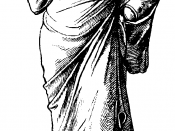In the poem Dover Beach, the poet uses conflicting imagery to give meaning to the poem. The differences in the way that the poet sees the relationship between the beach and the sea and the way that most people would see it become more pronounced as the poem develops. He also uses the change in attitude from the first stanza to the last to emphasize his message.
The poem starts with the normal image one would expect of a beach and a peaceful moonlit night, but quickly moves to an entirely different point of view. By the end of the first stanza the sea is no longer peaceful and calm, but crashing with a "grating roar". The poet has taken an image that most people associate with tranquility and turned it into a depressing scene. The stanza ends with "The eternal note of sadness" being brought in by the sea.
The poet is comparing the sea to the sum of all human troubles. The sea is eternal just as human suffering is eternal. The sea has also seen all of the human suffering and in it's roar the poet can hear that suffering.
When the poet talks about Sophocles and the Aegean he is clearly reinforcing the idea of the sea being the bearer of misery. The reference is to Sophocles tragic plays and the suffering that necessarily accompanied them. This image becomes powerful as the reader realizes that the poet is saying that he can hear the same message on Dover Beach that Sophocles heard so many years ago by the Aegean. He is basically saying that the nature of life doesn't change. There was suffering in the times of the Greeks, suffering in his time, and there will be suffering after he is gone.
The poet finishes...



Good Effort
Good essay but I feel sometimes I understood the poem differently, such as, when u said: "that no matter what happens misery and suffering will always be present in the world." I disagree, because the reader said at the last stanza: "Ah, love, let us be true
To one another!" he means that he want ppl to come together and help each other, but actually that does not happened. Also when he said: "The Sea of Faith
Was once" he is saying that there was faith before but not now.
Over all good essay but u did not actually explain the idea of the "grating roar" and what does it represent?
0 out of 0 people found this comment useful.